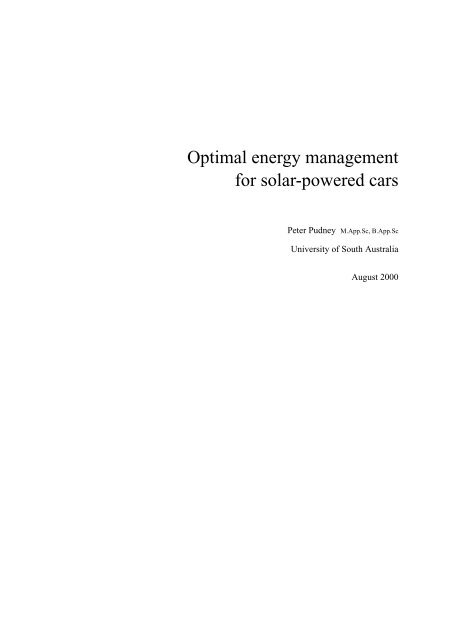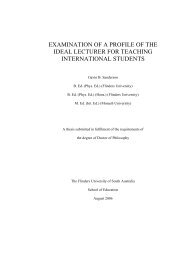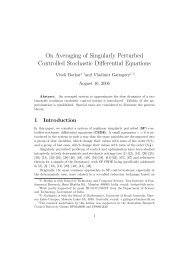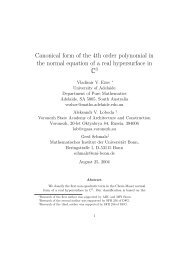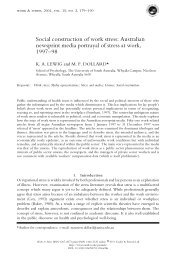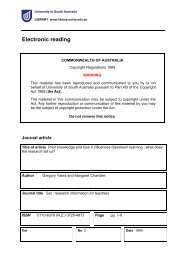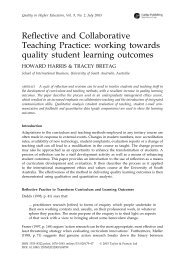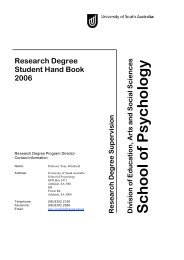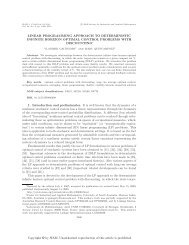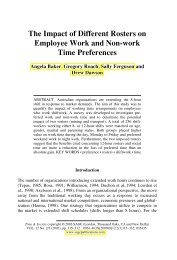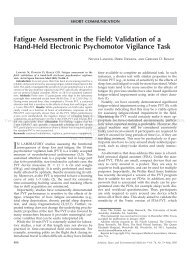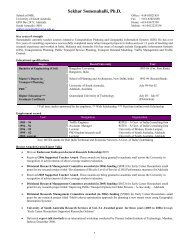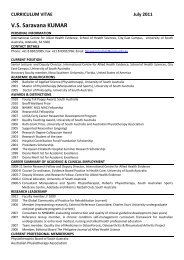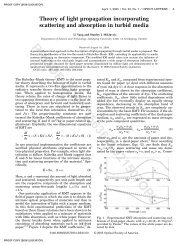Optimal energy management for solar-powered cars - Study at UniSA
Optimal energy management for solar-powered cars - Study at UniSA
Optimal energy management for solar-powered cars - Study at UniSA
Create successful ePaper yourself
Turn your PDF publications into a flip-book with our unique Google optimized e-Paper software.
<strong>Optimal</strong> <strong>energy</strong> <strong>management</strong><br />
<strong>for</strong> <strong>solar</strong>-<strong>powered</strong> <strong>cars</strong><br />
Peter Pudney M.App.Sc, B.App.Sc<br />
University of South Australia<br />
August 2000
Contents<br />
Summary........................................................................................................................... v<br />
Declar<strong>at</strong>ion.....................................................................................................................viii<br />
Acknowledgements.......................................................................................................... ix<br />
Introduction<br />
1 Motiv<strong>at</strong>ion..................................................................................................................... 2<br />
2 Solar <strong>cars</strong> and the World Solar Challenge.................................................................... 3<br />
2.1 Solar <strong>cars</strong> .......................................................................................................... 3<br />
2.2 The World Solar Challenge.............................................................................. 7<br />
2.3 Previous race results......................................................................................... 8<br />
2.4 Aurora Vehicles................................................................................................ 9<br />
2.5 Electric and hybrid <strong>cars</strong>.................................................................................. 10<br />
2.6 Using <strong>energy</strong> wisely ....................................................................................... 11<br />
3 The research problem.................................................................................................. 12<br />
Modelling the problem<br />
4 Solar power................................................................................................................. 15<br />
4.1 Solar irradiance............................................................................................... 15<br />
4.2 Photovoltaic cells ........................................................................................... 17<br />
4.3 Panel shape..................................................................................................... 18<br />
5 Energy storage ............................................................................................................ 23<br />
5.1 Electrochemical cells and b<strong>at</strong>teries ................................................................ 23<br />
5.2 B<strong>at</strong>tery models................................................................................................ 28
ii<br />
5.3 Ohmic b<strong>at</strong>tery model...................................................................................... 31<br />
5.4 Silver-zinc b<strong>at</strong>teries........................................................................................ 32<br />
5.5 Summary ........................................................................................................ 34<br />
6 The drive system......................................................................................................... 35<br />
6.1 Electric motors ............................................................................................... 35<br />
6.2 Motor controller ............................................................................................. 36<br />
6.3 Power losses in the motor and controller ....................................................... 36<br />
6.4 Transmission .................................................................................................. 37<br />
6.5 Summary ........................................................................................................ 37<br />
7 Problem model............................................................................................................ 38<br />
7.1 Power flows.................................................................................................... 38<br />
7.2 Equ<strong>at</strong>ions of motion ....................................................................................... 39<br />
7.3 Energy storage................................................................................................ 41<br />
7.4 Rot<strong>at</strong>ional dynamics....................................................................................... 42<br />
7.5 Summary ........................................................................................................ 43<br />
Efficient <strong>energy</strong> <strong>management</strong><br />
8 Minimising <strong>energy</strong> use................................................................................................ 45<br />
9 Formul<strong>at</strong>ion of an optimal control problem................................................................ 49<br />
9.1 Problem <strong>for</strong>mul<strong>at</strong>ion....................................................................................... 49<br />
9.2 Necessary conditions <strong>for</strong> a solution................................................................ 53<br />
9.3 Summary ........................................................................................................ 56<br />
10 <strong>Optimal</strong> control of a perfectly efficient car on a level road...................................... 57<br />
10.1 Problem <strong>for</strong>mul<strong>at</strong>ion..................................................................................... 57<br />
10.2 Necessary conditions <strong>for</strong> an optimal str<strong>at</strong>egy............................................... 59<br />
10.3 Control transitions in an optimal str<strong>at</strong>egy .................................................... 60<br />
10.4 Construction of an optimal str<strong>at</strong>egy ............................................................. 64<br />
10.5 A more precise <strong>for</strong>mul<strong>at</strong>ion.......................................................................... 65<br />
10.6 Compactness of the feasible set.................................................................... 67<br />
10.7 A feasible str<strong>at</strong>egy........................................................................................ 70<br />
10.8 Existence of an optimal str<strong>at</strong>egy .................................................................. 72<br />
10.9 Summary ...................................................................................................... 73<br />
11 An inefficient b<strong>at</strong>tery................................................................................................ 74<br />
11.1 Problem <strong>for</strong>mul<strong>at</strong>ion..................................................................................... 74
iii<br />
11.2 Control transitions in an optimal str<strong>at</strong>egy .................................................... 76<br />
11.3 Calcul<strong>at</strong>ion of transition points .................................................................... 80<br />
11.4 Existence of transition points ....................................................................... 82<br />
11.5 Example........................................................................................................ 90<br />
11.6 Summary ...................................................................................................... 93<br />
12 Gradients................................................................................................................... 94<br />
12.1 Problem <strong>for</strong>mul<strong>at</strong>ion..................................................................................... 94<br />
12.2 Necessary conditions <strong>for</strong> an optimal str<strong>at</strong>egy............................................... 96<br />
12.3 How many holding speeds?.......................................................................... 97<br />
12.4 Transitions.................................................................................................. 101<br />
12.5 Construction of an optimal str<strong>at</strong>egy ........................................................... 105<br />
12.6 Summary .................................................................................................... 106<br />
13 Realistic b<strong>at</strong>tery models.......................................................................................... 107<br />
13.1 Problem <strong>for</strong>mul<strong>at</strong>ion <strong>for</strong> an ohmic b<strong>at</strong>tery................................................. 107<br />
13.2 Necessary conditions <strong>for</strong> an optimal str<strong>at</strong>egy............................................. 109<br />
13.3 Construction of an optimal journey............................................................ 111<br />
13.4 Two ohmic b<strong>at</strong>teries ................................................................................... 116<br />
13.5 Silver-zinc b<strong>at</strong>tery ...................................................................................... 119<br />
13.6 Summary .................................................................................................... 124<br />
14 Drive losses............................................................................................................. 125<br />
14.1 Problem <strong>for</strong>mul<strong>at</strong>ion................................................................................... 125<br />
14.2 Constructing a phase portrait...................................................................... 127<br />
14.3 A practical str<strong>at</strong>egy <strong>for</strong> a long journey....................................................... 129<br />
14.4 Gradients .................................................................................................... 130<br />
14.5 Summary .................................................................................................... 132<br />
15 Sp<strong>at</strong>ially varying irradiance.................................................................................... 133<br />
15.1 Problem <strong>for</strong>mul<strong>at</strong>ion................................................................................... 133<br />
15.2 Necessary conditions <strong>for</strong> an optimal str<strong>at</strong>egy............................................. 134<br />
15.3 Construction of an optimal str<strong>at</strong>egy ........................................................... 136<br />
15.4 Solution of a ‘dark route’ problem............................................................. 137<br />
15.5 St<strong>at</strong>ionary brightness factor........................................................................ 138<br />
15.6 Summary .................................................................................................... 139<br />
16 Short-term str<strong>at</strong>egy ................................................................................................. 140<br />
16.1 Problem <strong>for</strong>mul<strong>at</strong>ion................................................................................... 140<br />
16.2 Necessary conditions <strong>for</strong> an optimal str<strong>at</strong>egy............................................. 141
iv<br />
16.3 Construction of a short-term str<strong>at</strong>egy......................................................... 143<br />
16.4 Example...................................................................................................... 143<br />
16.5 Summary .................................................................................................... 144<br />
17 Stochastic irradiance............................................................................................... 145<br />
17.1 A simple stochastic <strong>solar</strong> car problem........................................................ 145<br />
17.2 Solution of the deterministic problem........................................................ 146<br />
17.3 Modelling Adelaide’s <strong>solar</strong> irradi<strong>at</strong>ion....................................................... 147<br />
17.4 Solution of the stochastic problem ............................................................. 149<br />
17.5 Efficient frontiers ....................................................................................... 151<br />
17.6 Summary .................................................................................................... 154<br />
18 Calcul<strong>at</strong>ing a practical str<strong>at</strong>egy............................................................................... 155<br />
18.1 Str<strong>at</strong>egy principles...................................................................................... 155<br />
18.2 Predicting irradiance................................................................................... 156<br />
18.3 Finding the optimal speed profile............................................................... 157<br />
18.4 B<strong>at</strong>tery charge constraints .......................................................................... 159<br />
18.5 Following the b<strong>at</strong>tery charge profile .......................................................... 161<br />
18.6 The 1999 World Solar Challenge............................................................... 161<br />
18.7 Summary .................................................................................................... 167<br />
19 Beyond <strong>solar</strong> <strong>cars</strong>.................................................................................................... 168<br />
Bibliography ................................................................................................................. 170
Summary<br />
Solar <strong>powered</strong> <strong>cars</strong> may never be practical. Nevertheless, in the 1996 World Solar<br />
Challenge the Honda Dream carried two people 3000km across Australia <strong>at</strong> an average<br />
speed of 90km/h, <strong>powered</strong> only by sunlight. You clearly don’t need a 2500kg machine<br />
<strong>powered</strong> by polluting fuels to get you to work and back each day.<br />
The Australian Aurora 101 <strong>solar</strong> <strong>powered</strong> car requires less than 2000W of power to travel<br />
<strong>at</strong> 100km/h. To achieve such high per<strong>for</strong>mance the car has high aerodynamic efficiency,<br />
motor efficiency gre<strong>at</strong>er than 98%, low rolling resistance tyres, and weighs less than<br />
280kg with the driver in it. The <strong>energy</strong> used to propel the car is gener<strong>at</strong>ed by<br />
high-efficiency photovoltaic cells<br />
Another key to achieving high per<strong>for</strong>mance is efficient <strong>energy</strong> <strong>management</strong>. The car has<br />
a small b<strong>at</strong>tery th<strong>at</strong> can store enough <strong>energy</strong> to drive the car about 250km <strong>at</strong> 100km/h.<br />
Energy stored in the b<strong>at</strong>tery can be used when extra power is required <strong>for</strong> climbing hills<br />
or <strong>for</strong> driving under clouds. More importantly, <strong>energy</strong> stored while the car is not racing<br />
can be used to increase the average speed of the car.<br />
How should the b<strong>at</strong>tery be used? The motiv<strong>at</strong>ion <strong>for</strong> this problem was to develop an<br />
<strong>energy</strong> <strong>management</strong> str<strong>at</strong>egy <strong>for</strong> the Aurora <strong>solar</strong> racing team to use in the World Solar<br />
Challenge, a triennial race across Australia from Darwin to Adelaide. The real problem—<br />
with we<strong>at</strong>her prediction, detailed models of the car and numerous race constraints—is<br />
intractable. But by studying several simplified problems it is possible to discover simple<br />
rules <strong>for</strong> an efficient <strong>energy</strong> <strong>management</strong> str<strong>at</strong>egy.<br />
The simplest problem is to find a str<strong>at</strong>egy th<strong>at</strong> minimises the <strong>energy</strong> required to drive a<br />
car with a perfectly efficient b<strong>at</strong>tery and a constant drive efficiency. The optimal str<strong>at</strong>egy<br />
is to drive <strong>at</strong> a constant speed. This is just the beginning of the <strong>solar</strong> car problem, however.
vi<br />
More general problems, with more general models <strong>for</strong> the b<strong>at</strong>tery, drive system and <strong>solar</strong><br />
power, can be <strong>for</strong>mul<strong>at</strong>ed as optimal control problems, where the control is (usually) the<br />
flow of power from or to the b<strong>at</strong>tery. By <strong>for</strong>ming a Hamiltonian function we can use<br />
Pontryagin’s Maximum Principle to derive necessary conditions <strong>for</strong> an optimal str<strong>at</strong>egy.<br />
We then use these conditions to construct an optimal str<strong>at</strong>egy. The str<strong>at</strong>egies <strong>for</strong> the<br />
various simplified problems are similar:<br />
• On a level road, with <strong>solar</strong> power a known function of time, and with a<br />
perfectly efficient drive system and b<strong>at</strong>tery, the optimal str<strong>at</strong>egy has three<br />
driving modes: maximum power, speed holding, and maximum regener<strong>at</strong>ive<br />
braking.<br />
• If the perfectly efficient b<strong>at</strong>tery is replaced by a b<strong>at</strong>tery with constant <strong>energy</strong><br />
efficiency then the single holding speed is replaced by two critical speeds. The<br />
lower speed is held when <strong>solar</strong> power is low, and the upper speed is held when<br />
<strong>solar</strong> power is high. The b<strong>at</strong>tery discharges <strong>at</strong> the lower speed and charges <strong>at</strong><br />
the higher speed. The difference between the upper and lower critical speeds<br />
is about 10km/h. There are precise conditions <strong>for</strong> switching from one mode<br />
to another, but small switching errors do not have a significant effect on the<br />
journey.<br />
• If we now change from a level road to an undul<strong>at</strong>ing road, the optimal str<strong>at</strong>egy<br />
still has two critical speeds. With hills, however, the conditions <strong>for</strong> switching<br />
between driving modes are more complex. Steep gradients must be<br />
anticip<strong>at</strong>ed. For steep inclines the control should be switched to power be<strong>for</strong>e<br />
the incline so th<strong>at</strong> speed increases be<strong>for</strong>e the incline and drops while the car<br />
is on the incline. Similarly, <strong>for</strong> steep declines the speed of the car should be<br />
allowed to drop be<strong>for</strong>e the decline and increase on the decline.<br />
• With more realistic b<strong>at</strong>tery models the optimal control is continuous r<strong>at</strong>her<br />
than discrete. The optimal str<strong>at</strong>egy is found by following an optimal trajectory<br />
in the phase space of the st<strong>at</strong>e and adjoint equ<strong>at</strong>ions. This optimal trajectory<br />
is very close to a critical point of the phase space <strong>for</strong> most of the journey.<br />
Speed increases slightly with <strong>solar</strong> power. As be<strong>for</strong>e, the optimal speed lies<br />
within a narrow range <strong>for</strong> most of the journey.<br />
• Power losses in the drive system affect the initial power phase, the final<br />
regener<strong>at</strong>ive braking phase, and the speed profile over hills. The optimal<br />
speed still lies within a narrow range <strong>for</strong> most of the journey.
vii<br />
• With sp<strong>at</strong>ial vari<strong>at</strong>ions in <strong>solar</strong> power it is possible to vary the speed of the car<br />
in such a way th<strong>at</strong> the extra <strong>energy</strong> collected more than compens<strong>at</strong>es <strong>for</strong> the<br />
extra <strong>energy</strong> used. Speed should be increased under clouds, and decreased in<br />
bright sunlight. The benefits of ‘sun-chasing’ are small, however.<br />
• Solar power is not known in advance. By modelling <strong>solar</strong> power as a Markov<br />
process we can use dynamic programming to determine the target distance <strong>for</strong><br />
each remaining day of the race. Altern<strong>at</strong>ively, we can calcul<strong>at</strong>e the probability<br />
of completing the race <strong>at</strong> any given speed.<br />
These principles of efficient control have been used successfully since 1993 to develop<br />
practical str<strong>at</strong>egy calcul<strong>at</strong>ions <strong>for</strong> the Aurora <strong>solar</strong> racing team, winner of the 1999 World<br />
Solar Challenge.
Declar<strong>at</strong>ion<br />
I declare th<strong>at</strong> this thesis does not incorpor<strong>at</strong>e without acknowledgment any m<strong>at</strong>erial<br />
previously submitted <strong>for</strong> a degree or diploma in any university; and th<strong>at</strong> to the best of<br />
knowledge it does not contain any m<strong>at</strong>erials previously published or written by another<br />
person except where due reference is made in the text.
Acknowledgements<br />
I was introduced to <strong>solar</strong> <strong>cars</strong> in 1993, about six months be<strong>for</strong>e the World Solar Challenge.<br />
The Aurora team had decided to use non-rechargeable lithium b<strong>at</strong>teries <strong>for</strong> half of their<br />
b<strong>at</strong>tery pack, but was not sure when to use them. Aurora approached the CSIRO Division<br />
of M<strong>at</strong>hem<strong>at</strong>ics and St<strong>at</strong>istics <strong>for</strong> help. Phil Howlett and I were drawn into the group<br />
because of our previous work on optimal train control. Together we solved the b<strong>at</strong>tery<br />
problem, and, supported by a CSIRO–University of South Australia Research Grant, went<br />
on to develop a driving str<strong>at</strong>egy <strong>for</strong> the race. In October 1993 I raced across Australia with<br />
Aurora; we were the first Australian team to finish, and fifth overall.<br />
In 1994 Aurora started building a new car, the Aurora 101. The aim was to win the 1996<br />
World Solar Challenge. Many people and organis<strong>at</strong>ions contributed to the campaign. I<br />
worked on refining the driving str<strong>at</strong>egy, supported by an ARC Collabor<strong>at</strong>ive Research<br />
Grant. Sadly, the race ended <strong>for</strong> us when we crashed just 32km south of Darwin.<br />
Several people <strong>at</strong> the University of South Australia have helped and inspired me: Phil<br />
Howlett, my supervisor and co-author of many papers; Basil Benjamin, my associ<strong>at</strong>e<br />
supervisor; John Boland, who helped develop <strong>solar</strong> irradi<strong>at</strong>ion models; and Peter<br />
Murphy—I gained a much better appreci<strong>at</strong>ion of the technology when I helped design and<br />
build Ned 26 with the South Australian Solar Car Consortium.<br />
Finally, I would like to thank Aurora, who introduced me to <strong>solar</strong> <strong>cars</strong> and have taught me<br />
so much about design and engineering; the team members th<strong>at</strong> designed, built and raced<br />
the Aurora Q1, the team th<strong>at</strong> designed, built and almost raced the Aurora 101, and the<br />
1999 race team who improved and rebuilt the 101, and who didn’t say a thing when other<br />
teams passed us.


